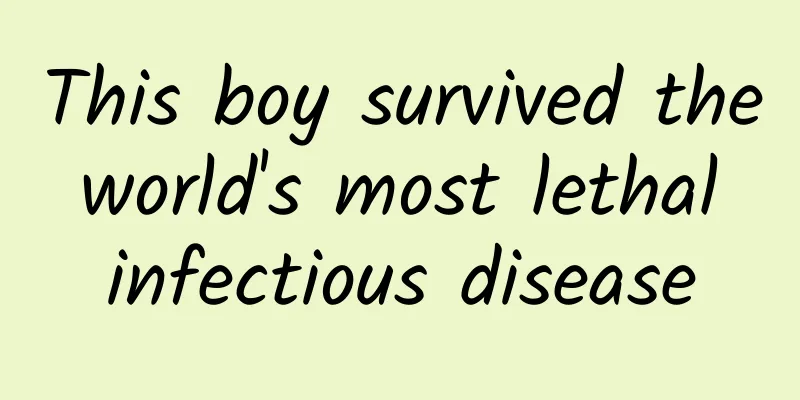This boy survived the world's most lethal infectious disease

|
One evening in 1970, an anxious man came to a hospital in Ohio, USA. He held a five or six-year-old boy in one hand and a huge brown bat in the other. When the man saw the doctor, he immediately picked up the child, raised the boy's left hand and said, "Doctor, my child was bitten by a bat, and his finger is about to fall off!" Photo: A family of patients whose fate was changed by rabies Upon seeing this, the doctor immediately checked the child's wound and saw that the bite mark on the child's left thumb was very deep. The doctor asked, "How did you get bitten? Did you rinse it?" The man replied, "I simply wiped off the blood and rushed to the hospital. He was playing on the windowsill just now, and this bat was lying on the windowsill. My son Matthew Winkler tried to catch it and was bitten." The man turned around and pointed at the brown bat on the ground and said, "This is it. If I hadn't killed it, it would have tried to bite people." The doctor listened and rinsed the boy's thumb with running water. The boy started crying again because of the pain. The doctor comforted the six-year-old boy and said to the boy's father: "The bite was very deep. You should have washed it with soapy water immediately to remove the virus from the wound." The boy's father nodded. The doctor looked at the bat and said: "Is this a wild bat? We need to check it to see if it carries rabies or other dangerous viruses, and then determine whether your son is safe and needs further treatment." After the doctor cleaned the wound of the boy named Winkler, he asked his father to take him home. The man returned home and was very uneasy because he knew that once rabies took effect, he would die. He could not realize at this time that so many unexpected things would happen later. If you want to truly understand the peculiarity of this case, I must first give you an in-depth understanding of this deadly infectious disease - rabies. A brief history of rabies Most people may think that rabies is only transmitted by dog or cat bites, but they don’t know that bat bites also carry this risk. Bats are mammals, and like cats and dogs, they can also carry rabies. Moreover, bats are most likely the original host of rabies. Using modern molecular biology, scientists have traced the phylogenetic history of rabies. They conducted genetic sequence analysis on rabies viruses carried by six internationally recognized rabies hosts: dogs, bats, raccoons, skunks, foxes, and mongooses.
The earliest record of rabies appeared in the Mesopotamian Kingdom (now in Iraq) in 2300 BC. The Ishnenna Code states: "If a dog is mad and the authorities have informed its owner of the fact, but the owner does not keep the dog at home, so that the dog bites a person and causes death, the dog's owner shall pay 27 coins. It was not until 1885 that humans really had a way to deal with rabies. The famous microbiologist Pasteur developed a rabies vaccine, which really removed the equation between "being bitten by a mad dog" and "death". Pasteur found that exposing the infected rabbit spinal nerves to the air to reduce the toxicity only took 14 days, and the virus was almost completely non-toxic. He ground the weakened rabbit spinal nerves into powder according to different toxicities, mixed them with distilled water to make an emulsion, and injected them into patients for 14 consecutive days, and the patients gradually developed antibodies. Generally speaking, the incubation period of rabies virus in the patient's body is 2 to 3 months. In rare cases, the incubation period can be as long as several years, or as short as a few days. However, at that time, Pasteur actually only found a way to prevent rabies, not to treat rabies, and he did not really understand the cause of rabies. Because at that time, humans did not know that in addition to bacteria, there were viruses in nature that were much smaller than bacteria. Seven years later, in 1892, Ivanovsky discovered tobacco mosaic virus on tobacco leaves, and the concept of "virus" was first known to the world. Today, medical scientists can clearly see the appearance of rabies virus with the help of electron microscopes. Our understanding of rabies virus is also getting deeper and deeper. Terrible rabies virus <br /> Rabies virus is a neurotropic virus that looks like a bullet and belongs to the genus Lysavirus and the family Rhabdoviridae. The name "Lisa" comes from the goddess of madness and madness in Greek mythology. Rabies virus is similar to other viruses. It has a weak ability to survive outside the body. It is afraid of heat, sunlight, dryness, and is sensitive to ultraviolet rays. It is easily inactivated by strong acids, strong alkalis, soapy water and other detergents. But we must remember that once a virus that can be easily killed outside the body enters the human body, it cannot be eliminated by drinking disinfectant or Lianhua Qingwen. The rabies virus has a very special ability. After entering the human body, ordinary viruses will spread throughout the body through the blood, but after entering the human body, the rabies virus goes straight to the nervous system. It does not spread through the blood, but advances along the nervous system at an average speed of 3 mm per hour in the peripheral nervous tissue toward the central nervous system. Therefore, the farther the wound is from the brain and spinal cord, the longer the incubation period. Once it reaches the central nervous tissue, it can multiply and spread rapidly within a day, destroying the brain and spinal cord. At this time, the patient will begin to develop a series of symptoms. The symptoms of rabies are also extremely terrifying. Encephalitis type: The symptoms are what we usually know as fear of wind and water, excitement and mania. Paralysis type: The patient will experience paralysis or weakness in the limbs from the wound, and slowly fall into a coma and die. Regardless of the type, the disease is caused by the virus invading the patient's brain tissue. In the early stages of encephalitis rabies, the virus may replicate in local dorsal root nerve centers and ganglia, at which point the patient will experience some neurological symptoms, such as abnormal pain or itching in the wound, and abnormal sensations such as ants crawling. Subsequently, nerve cells carry a substance called acetylcholine receptors to exchange information with muscle cells and skin cells, and the rabies virus takes the opportunity to bind to acetylcholine and follow it to the nerve cells. Then, like a tourist who finally gets on a ride, the virus slowly ascends along the axons of the nerve cells to the spinal cord, then follows the spinal cord to the brainstem, and then pours into the brain. Once the virus invades the brain, people begin to get sick. Some people will feel sick, have a fever, fatigue, nausea and restlessness, some people will be extremely sensitive to external stimuli such as pain, sound and light, and some people will feel a tightening in the throat. The symptoms vary. These are actually the symptoms of the transition period when the virus transfers from the peripheral nerves to the central nerves. Depending on the infection, this initial stage can last 2-10 days. According to statistics, 80% of rabies patients will have a strong reaction to water to varying degrees. Drinking water, hearing the sound of running water, and seeing water can cause spasms in the throat muscles, and then the patient often suffocates and dies due to severe spasms in the throat. This strong reaction to water is currently only seen in rabies, so rabies is also known as hydrophobia. Medically, this period is called the "mid-spasm period", which generally lasts 1-3 days. At this time, the virus multiplies in large numbers in the central nervous system, and the damage caused is irreversible. Modern medicine is helpless and can only hope for a miracle. Another type of paralytic rabies: After the patient is infected with the rabies virus, he will feel unwell and confused in the early stage, and then go into a coma directly, skipping the mid-term irritability symptoms. This also allows such patients to maintain sufficient physical strength and prolong their survival time. But once the patient falls into a coma, the virus enters the central nervous system, and death is not far away. Back to the beginning. Four days after Winkler's left thumb was bitten, his father finally waited anxiously for a call from the hospital. The doctor on the phone said, "Is that Winkler's father? We tested the bat that bit the boy and confirmed that it carried rabies virus in its oral tissue and spinal cord. Please bring Winkler to the hospital as soon as possible. We need to vaccinate him." Everyone thought Winkler was saved. In that era, vaccines saved countless lives with a very high success rate. But unexpectedly, two days after Winkler completed the vaccination, that is, 20 days after being bitten by a bat, he began to have pain in his neck, which slowly extended to his back, and then to his head and legs. Along with the pain, the boy's consciousness gradually became blurred. Obviously, he began to show typical symptoms of rabies. But to everyone's surprise, a miracle happened. On the fifth day of Winkler's illness, his consciousness gradually recovered. The doctor tested his biochemical indicators again and found that the antibodies in his cerebrospinal fluid and serum increased significantly. Winkler's condition got better day by day. Two months later, Winkler miraculously recovered and was discharged from the hospital. Three months later, the results of Winkler's reexamination showed that the neutralizing antibody titer in his body reached a peak. No rabies virus was isolated from Winkler's brain tissue, cerebrospinal fluid, and saliva. Historically, cases like Winkler's who developed the disease and survived are extremely rare, and can be counted on one hand. All the surviving cases have one thing in common: they developed the disease after receiving the vaccine. In the final analysis, it was the vaccine that worked. Current status of rabies <br /> Rabies is still widespread around the world. Except for Antarctica and some islands, rabies is found in more than 150 countries on all continents of the world, 95% of which occur in Asia and Africa. Every year, 26,000 to 55,000 people still die from rabies, and the vast majority of deaths are caused by transmission from dogs to humans. In Europe and Australia, where dog rabies is almost eliminated, bats are the most common carriers of rabies virus. Since records began in 1950, my country has experienced three rabies epidemic peaks, with the most recent peak occurring in 2007. That year, 3,300 rabies deaths were reported nationwide. Since then, the data has shown a steady downward trend. By 2019, a total of 290 cases of rabies had been reported nationwide, widely distributed in 222 counties and districts, a 91% decrease from the peak of the epidemic in 2007. Specifically: When bitten by a small animal, bleeding or subcutaneous tissue may be visible to the naked eye. Broken skin is licked by small animals. Your own mucous membranes are contaminated by animal saliva (tip: never kiss your pets unless necessary). Note in particular that the above three situations also apply to bats. In the event of level 3 exposure, in addition to going to the hospital to treat the wound and getting vaccinated, you must also be injected with rabies passive immunization agents. Special attention should be paid: Once level 2 or above exposure occurs, do not suck the wound with your mouth, because after the virus invades the oral mucosa, it is closer to the brain and more dangerous. When cleaning wounds, you should also pay attention to the following: Unlike ordinary cleaning, wounds exposed to the risk of rabies need to be cleaned alternately with soapy water (or other weak alkaline cleaning agents) under a certain pressure of running water for at least 15 minutes. The purpose is to reduce or remove viruses and bacteria in the wound and reduce the risk of infection. When flushing, the water flow should be at a certain angle to the wound and should not be perpendicular to the wound surface to avoid flushing viruses and pollutants deep into the wound. If you know that you have received rabies vaccine before, you should also pay attention to the following: the current immunity protection period of the vaccine in my country is 6 months. If it has been more than 6 months since the last rabies vaccine was given, you need to be vaccinated again. You may have heard that the 10-day observation method for rabies is widely used in Europe and the United States. However, because China is still a high-risk area for rabies, especially in the vast rural areas of China, unlike some European and American countries where rabies has been basically eliminated, the 10-day observation method widely used in European and American countries should not be applied. A few years ago, Liu Cixin, the author of The Three-Body Problem, went to Finland to attend the World Science Fiction Convention and was unfortunately bitten by a local dog. What shocked the Chinese people was that the local hospital in Finland did not have rabies vaccines. Because Finland had not seen a case of rabies for many years, the country had almost forgotten about this infectious disease. This incident caused a great response in the science fiction circle at the time, and everyone offered advice. Fortunately, this happened in Finland, a risk-free area, and Liu was safe and sound. On January 28, 2021, the World Health Organization also mentioned future plans for rabies in its newly released "2021-2030 Neglected Tropical Diseases Roadmap". Faced with this ancient and somewhat terrifying infectious disease, people are still struggling to completely eliminate dog-to-human rabies. |
Recommend
Sudden increase in menstruation and blood clots
Women will be troubled by menstruation after they...
What fertilizer should be used for hibiscus during its flowering period? What fertilizer should be used for hibiscus during its flowering period?
Hibiscus is very common in life. Because of its g...
How big is the gestational sac at 47 days of pregnancy?
After pregnancy, the fetus is not formed immediat...
How do girls use sanitary napkins?
Girls will have their periods when they reach pub...
Is Delta still prevalent in China? Are there any new variants? Official response
Recently, the number of newly infected people in ...
What are the early symptoms of ectopic pregnancy at 40 days?
Generally, pregnant women will show signs of ecto...
Are goldfish easy to keep alive? How to keep a newly bought goldfish alive?
As people's quality of life improves, more an...
How to deal with swollen and painful gums during breastfeeding and how to care for them
The breastfeeding period is also commonly referre...
Female lower body odor
In life, many female friends are often troubled b...
What causes chronic pelvic pain?
Chronic pelvic pain is a common female disease. I...
Can I have an induced labor at 22 weeks?
Many female friends have to undergo induced labor...
Constipation in the elderly is not a trivial matter. Do these things to have a smooth bowel movement! Easily solve the "inconvenience" secret
Constipation is a common digestive tract symptom ...
Woman's hands and feet are weak and limbs are weak
Because of women's special physiological phen...
If I had a caesarean section for my first child, can I have a natural birth for my second child?
If the first child was delivered by caesarean sec...









